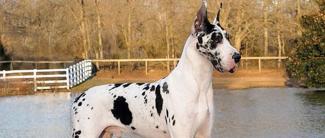She gently held Magic in an upright position as she fed the dog, patting her sides for 30 minutes to ensure the food moved to the stomach. No matter how hard she worked, the Great Dane frequently regurgitated. Next, Wowdzia tried feeding Magic with the dog’s front feet propped on the edge of the bathtub. She worked with the dog for an hour, holding the dog’s legs while patting her sides and massaging her neck in a downward motion. She repeated this eight times a day. After much trial and error, Magic, now 5 years old, weighs 75 pounds and can eat from a bowl on the floor. The dog even sits tall on her own to help settle her food. “Breeders and owners should keep trying new things until they find a feeding routine that works for their megasesophagus-affected dogs,” Wowdzia says. “This condition is challenging, but dogs can live long, happy lives if their megaesophagus is properly managed.” Purina appreciates the support of the Great Dane Club of American and particularly Neil O’Sullivan, PhD, chair of the GDCA Health and Research Committee, in helping to identify topics for the Purina Pro Club Great Dane Update newsletter. Great Dane Owners Can Help Advance Megaesophagus Research Breeders and owners of Great Danes, particularly puppies, affected by megaesophagus are encouraged to submit blood samples for genetic research underway at Clemson University. The Great Dane Club of America is helping to fund the study. For information about participating in the research, please contact Leigh Anne Clark, PhD, assistant professor in the Department of Genetics and Biochemistry, at lclark4@clemson.edu. GDCA Charitable Trust Donations Can Be Earmarked for Megaesophagus Research The Great Dane Club of America Charitable Trust allows Great Dane enthusiasts who make tax-deductible charitable donations to designate them for megaesophagus research. The funding will be used to help collect DNA samples for the genetics study at Clemson University.

